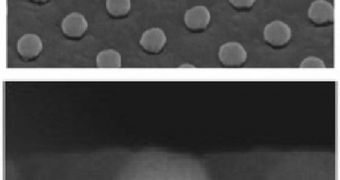In a paper published in the October 7 issue of the scientific journal Optics Express, physicists at the Princeton University show that trying to block the path of a light beam by covering the hole through which it passes tends to enhance the photon stream, rather than subdue it.
Conventional wisdom holds that placing an obstacle over a hole through which light penetrates a room, for example, would block all radiations from entering. However, experts at the university find that the exact opposite of that is true.
Their experiments were carried out using very tiny holes and small metal caps. The holes were punched in a thin metal film, and the entire construct bathed in light. The goal was to see how photons behaved once the caps were applied to the tiny holes.
What the team observed is the direct result of the intricate interactions that can occur at only the tiniest scales. After applying the caps, the team analyzed the amount of photons passing through, and determined that as many as 70 percent more photons were passing through.
In other words, applying the obstacle actually made it easier for photons to penetrate the small opening. The researchers were baffled to notice this, but they did manage to come up with a few potential explanations for how and why the phenomenon might occur.
“The common wisdom in optics is that if you have a metal film with very small holes and you plug the holes with metal, the light transmission is blocked completely. We were very surprised,” explains Stephen Chou, an electrical engineer at the university.
He also holds an appointment as the Princeton Joseph Elgin professor of engineering. These results may be used to replace or modify a large number of processes currently being used in applications such as blocking light at nanoscale. Second-degree ramifications are staggering as well, the group believes.
One critical application that could change as a result of this study is photolitography. This is the method through which nanoscale patterns are inscribed on various materials. The technique is primarily used to construct integrated circuits and microprocessors.
It may also be possible to use the data to create devices capable of amplifying light significantly. Such advancements would lead to even more developments in the field of optical physics, the team says.
The new investigation was supported with funds from the Defense Advanced Research Agency (DARPA) and the US National Science Foundation (NSF).

 14 DAY TRIAL //
14 DAY TRIAL //